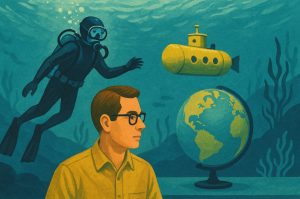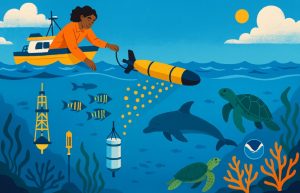Why Did NASA Stop Exploring the Ocean?
NASA is universally associated with space exploration, but few realise that the agency has also played a significant role in exploring Earth’s oceans.
In fact, NASA’s involvement with the ocean dates back decades, tied closely to its Earth science missions and interest in planetary processes.
Over time, however, a widespread belief has taken root: that NASA stopped exploring the ocean altogether. This assumption, fuelled by viral internet theories and speculation, has led many to wonder what prompted such a shift.
Did NASA really discover something strange in the deep sea, or is there more to the story? This article explores NASA’s role in ocean exploration, what it discovered, and the facts behind the myths.
What Sparked NASA’s Involvement in Ocean Exploration?

NASA’s connection to ocean exploration began as part of its broader mission to understand Earth as a complex, interconnected system. During the 1960s, NASA’s interests weren’t limited to outer space.
The agency recognised that Earth’s oceans, which cover more than 70% of the planet’s surface, were critical to studying global climate patterns and supporting its satellite programmes.
Astronauts also trained underwater to simulate the conditions of weightlessness experienced in space. This led to increased collaboration with oceanographers and deep-sea researchers, allowing NASA to study the ocean as both a training environment and a subject of scientific inquiry.
The similarities between the unknowns of deep space and the deep ocean made the latter an ideal analogue for space missions. NASA’s Earth Science Division was tasked with observing planetary changes from space.
In doing so, it frequently examined ocean currents, sea surface temperatures, and ocean-atmosphere interactions, laying the groundwork for many of its satellite-based Earth observation systems that continue today.
What Was NASA’s Original Purpose for Ocean Exploration?
NASA’s exploration of the ocean was never about sending divers or submarines to the sea floor like marine biologists might do.
Its original purpose was rooted in science and satellite observation, designed to better understand how the oceans influence Earth’s climate and weather systems.
The agency viewed oceans as key components of the Earth system and essential to monitoring environmental change.
What Are the NASA’s Objectives?
- Tracking sea surface temperatures to study climate variability and global changes
- Monitoring ocean circulation patterns to understand global heat distribution and seasonal shifts
- Studying ocean salinity to examine its influence on weather and climate patterns
- Mapping ocean heights and tides using satellite altimetry for accurate predictions
- Collaborating with agencies like NOAA for joint data gathering and analysis
NASA’s role was primarily observational, using its satellite technologies to gather data from space. This allowed scientists to study large-scale ocean phenomena such as El Niño, ocean acidification, and rising sea levels. Over time, these missions became an integral part of understanding climate change.
Though NASA’s role differed from traditional deep-sea exploration missions conducted by marine organisations, it was instrumental in laying a technological foundation for modern oceanographic research.
What Has NASA Discovered About the Ocean So Far?

NASA has made numerous discoveries about the ocean, primarily through its satellite-based Earth observation missions. The agency has been able to track changes in sea surface temperatures globally, helping to monitor climate patterns and predict extreme weather events such as hurricanes and droughts.
One of the key discoveries is how the oceans act as heat sinks, absorbing over 90% of the excess heat caused by greenhouse gas emissions.
NASA also discovered how ocean currents play a crucial role in distributing heat around the globe, affecting everything from regional climates to agricultural patterns.
Through missions like TOPEX/Poseidon and its successors, NASA has mapped ocean surface heights, revealing the impacts of climate variability, such as El Niño and La Niña.
It also contributed to measuring sea level rise and ocean salinity, improving global climate models. These findings not only benefit environmental monitoring but also help governments and industries prepare for future environmental changes.
How Long Did NASA Explore the Ocean?
NASA’s engagement with ocean exploration has spanned several decades, and it’s important to clarify that it never truly stopped. Its initial involvement began in the 1960s and has continued in various forms through to the present day.
While many people believe NASA ended its ocean research abruptly, the truth is more nuanced. Over time, NASA’s role became more focused on satellite monitoring, allowing it to observe ocean dynamics from space.
Rather than directly exploring the deep sea using submarines or manned vessels, NASA continued contributing to ocean science through missions like Aqua, Jason-3, and Sentinel-6.
These missions collect critical data on sea level rise, ocean temperatures, and climate variability. They are still active and maintained in partnership with organisations like NOAA and the European Space Agency.
The misconception that NASA stopped exploring the ocean stems largely from viral internet theories, not fact.
The agency has simply evolved its approach to ocean research by leveraging space-based tools rather than undersea missions.
Why Did NASA Stop Exploring the Ocean?
The idea that NASA “stopped” exploring the ocean is misleading. The agency never abandoned ocean research but shifted focus to areas where its expertise is most valuable space and satellite-based Earth observation. Here are the key reasons for the transition:
Budget Prioritisation

NASA operates within a limited annual budget allocated by the U.S. government. Given its primary mission is space exploration launching satellites, studying planets, and preparing for Moon and Mars missions most resources are directed there.
While ocean research is essential for understanding Earth’s climate, it typically falls under agencies like NOAA. Since NASA is the world’s leading space agency, funding prioritises high-profile projects like Mars rovers and the Artemis programme, making ocean exploration a lower priority.
Division of Roles

A clear division of roles exists among U.S. agencies. NASA excels at large-scale Earth monitoring from space, while NOAA is specifically designed for hands-on ocean exploration.
NOAA manages ships, submarines, and remote vehicles to collect physical ocean data. NASA, however, provides satellite imagery and atmospheric insights, helping NOAA improve mission planning and analysis.
Technological Strategy

NASA focuses on deploying satellites to observe ocean surface temperatures, sea level changes, and currents, offering a global perspective. Deep-sea exploration, however, requires pressure-resistant vehicles and sonar mapping, which fall outside NASA’s expertise.
Instead of developing these technologies, NASA invests in satellite-based tools that complement but do not replace direct ocean research. This allows NASA to contribute without duplicating efforts.
Public Interest and Policy

Public perception influences funding decisions, and space exploration excites people more than deep-sea research. Missions to Mars and telescopes like James Webb capture global attention and drive national prestige.
In contrast, ocean exploration rarely dominates headlines or political discourse. As a result, marine science projects are often delegated to specialised agencies, while NASA continues its high-profile space missions.
The myth that NASA stopped ocean exploration due to a secret discovery is baseless. Science Feedback confirms that NASA continues ocean research through advanced satellite monitoring.
How Is Ocean Exploration Different from Space Exploration?

Although ocean and space exploration share some similarities both involving harsh, unexplored environments they are fundamentally different in scope, technology, and purpose.
What Are the Key Differences Include?
- Public Appeal: Space exploration captures the imagination more readily than ocean studies.
- Cost and Scale: Deep ocean missions are expensive but often receive less funding than space programmes.
- Technology Requirements: Ocean exploration involves dealing with high-pressure, corrosive environments, while space exploration must overcome vacuum and radiation challenges.
- Data Collection: Space data is often gathered remotely via satellites, whereas ocean data may require direct collection.
- Exploration Goals: Space exploration seeks new worlds and potential life, while ocean exploration focuses on understanding Earth’s climate and biodiversity.
NASA’s primary objective is to explore outer space. It employs satellites to study the ocean but leaves deep-sea missions to marine-specific agencies. This division is practical, efficient, and avoids duplication of efforts.
While both forms of exploration are crucial, the way they are conducted differs significantly. NASA continues to support ocean science, but through tools best suited to its expertise those that orbit the planet, not dive beneath it.
What Role Does NASA Play in Ocean Mapping and Monitoring Today?
NASA’s current involvement in ocean science revolves around advanced satellite technology and data interpretation.
Through missions like Aqua, Terra, and the Surface Water and Ocean Topography (SWOT) mission, NASA monitors vast stretches of the global ocean in real time.
Its satellites measure sea surface height, temperature, salinity, and even ocean colour — which can indicate algal blooms or pollution.
These datasets are vital for understanding how the oceans regulate Earth’s temperature, how they affect climate change, and how they influence severe weather events.
NASA’s work is particularly important for mapping large-scale ocean circulation patterns like the Gulf Stream.
Using satellites, it can track how these currents shift due to melting polar ice or warming seas. The agency also plays a role in educating the public and policymakers by making this data publicly accessible.
In collaboration with NOAA and other international space agencies, NASA provides a continuous stream of valuable information that benefits both scientific communities and global populations reliant on ocean health.
Why Is So Much of the Ocean Still Unexplored?

Despite technological advances, over 80% of the world’s oceans remain unmapped and unexplored. This is due to both physical challenges and funding limitations, making deep-sea exploration a slow and complex process.
The deep ocean presents an incredibly harsh environment with near-freezing temperatures, total darkness, and extreme pressure. Specialized equipment is required to withstand these conditions, making missions costly and logistically difficult.
Unlike space, where satellites can quickly cover vast distances, ocean exploration relies on slower methods such as sonar mapping and remotely operated vehicles.
Another major factor is funding and public interest. While the ocean is crucial for climate regulation, biodiversity, and human life, it does not capture political or public fascination like space exploration. As a result, ocean research receives less financial support.
Agencies like NOAA and WHOI continue efforts to improve ocean mapping, but progress is gradual. Although NASA provides satellite data that aids research, deep-sea exploration remains a significant challenge that will take decades to fully address.
What Are the Biggest Myths Around NASA’s Ocean Missions?
Over the years, many myths and conspiracies have emerged suggesting that NASA stopped exploring the ocean after discovering something mysterious. These stories often go viral online but are not supported by scientific facts or credible sources.
Popular Myths Include
- NASA discovered an unknown sea creature and halted operations
- The agency found alien technology on the sea floor
- NASA shifted to space exploration to avoid deep-sea dangers
- Secret underwater bases were identified, leading to mission closure
These misconceptions arise from misunderstandings and a fascination with the unknown. In reality, NASA’s role has always been observational, focusing on satellite data and climate modeling.
Science Feedback confirms that NASA’s Earth Science Division actively studies oceans through remote monitoring. NASA didn’t stop ocean research; it shifted to tracking global oceanographic patterns.
Myths persist due to the ocean’s mystery and limited public awareness of NASA’s work. Understanding the facts helps us appreciate NASA’s vital contributions to ocean science.
How Does Ocean Research Help NASA Understand Earth’s Climate?

NASA’s satellite-based ocean research is crucial for understanding Earth’s climate. Oceans play a key role in regulating global temperatures, absorbing carbon dioxide, and influencing weather patterns.
By studying the ocean, NASA helps scientists predict climate trends and assess environmental changes.
Key Climate Insights from Ocean Research
- Sea Surface Temperature: Tracking ocean temperatures helps forecast hurricanes and cyclones, improving disaster preparedness.
- Ocean Salinity: Measuring salt levels provides insights into rainfall patterns, evaporation rates, and the water cycle.
- Ocean Circulation: Studying currents reveals climate patterns like El Niño and La Niña, which impact global weather.
- Sea Level Rise: Monitoring ocean heights helps assess melting ice caps and the effects of global warming.
- Carbon Absorption: Understanding how oceans store carbon helps evaluate human impact on climate change.
NASA’s advanced satellites, like Aqua and Sentinel-6, provide critical data for climate modeling and policy decisions.
Studying ocean systems helps us prepare for extreme weather, protect ecosystems, and mitigate global warming. Ocean research remains a central part of NASA’s Earth science mission.
Who Is Responsible for Ocean Exploration if Not NASA?
While NASA supports ocean monitoring through space-based technology, it is not the primary agency responsible for deep-sea exploration.
That responsibility mainly lies with organisations like NOAA (National Oceanic and Atmospheric Administration), which leads most U.S. government efforts in marine science.
NOAA operates research vessels, underwater drones, and deep-sea submersibles to study the ocean’s physical, chemical, and biological characteristics.
In the UK, the National Oceanography Centre and British Antarctic Survey play similar roles. Globally, UNESCO’s Intergovernmental Oceanographic Commission (IOC) coordinates marine science collaboration.
NASA partners with these institutions by providing satellite data that enhances in-situ research. Joint missions like Jason-3 and SWOT, co-managed by NASA, CNES (France), and ESA (Europe), ensure a more complete understanding of Earth’s least explored resource.
Final Thoughts
The idea that NASA stopped exploring the ocean is a misconception. NASA remains deeply involved in ocean science through satellite technology and global partnerships.
While it doesn’t conduct deep-sea dives, its data supports climate research, ocean mapping, and environmental monitoring.
Instead of direct exploration, NASA focuses on observing Earth’s systems from space, identifying large-scale patterns and trends. This data helps other organizations protect ecosystems and prepare for climate change.
Understanding NASA’s role in ocean exploration highlights how science, technology, and collaboration contribute to safeguarding our planet’s future.
FAQs About Why Did NASA Stop Exploring the Ocean
Why does NASA invest more in space than in the ocean?
NASA’s core mission is space exploration, while ocean research is largely handled by NOAA and other marine agencies with specialised resources.
What technologies does NASA use for studying the oceans?
NASA uses satellites with instruments that measure ocean temperature, salinity, sea levels, and other climate-related metrics.
Is NASA collaborating with other agencies for ocean exploration?
Yes, NASA works closely with NOAA, ESA, and international partners to share data and co-manage ocean observation missions.
How does ocean exploration benefit space research?
Ocean environments help simulate space conditions for astronaut training and develop technologies used in both fields.
Many viral myths claim alien findings, but none are backed by science or NASA’s documented research missions.
How much of the ocean floor has NASA actually mapped?
NASA’s satellites can estimate surface height, but deep ocean floor mapping is primarily conducted by NOAA and oceanographic institutions.
What are some real discoveries NASA made in the ocean?
NASA has helped uncover major data on sea level rise, heat absorption, and ocean circulation that directly impact climate science.







